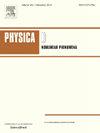在图上学习粗粒度动态
IF 2.7
3区 数学
Q1 MATHEMATICS, APPLIED
引用次数: 0
摘要
我们考虑了一个图神经网络(GNN)非马尔可夫建模框架来识别图上的粗粒度动态系统。我们的主要想法是通过检查Mori-Zwanzig记忆项的领先项如何依赖于编码图拓扑的粗粒度交互系数来系统地确定GNN架构。基于这一分析,我们发现考虑K-hop动态交互的适当GNN架构必须采用至少2K步的消息传递(MP)机制。在假设相互作用强度呈幂律随跳距衰减的情况下,我们还推断出精确闭合模型所需的记忆长度随相互作用强度的函数而减小。在异质Kuramoto振荡器模型和电力系统两个例子上的数值演示表明,所提出的GNN架构可以预测固定和时变图拓扑下的粗粒度动力学。本文章由计算机程序翻译,如有差异,请以英文原文为准。
Learning coarse-grained dynamics on graph
We consider a Graph Neural Network (GNN) non-Markovian modeling framework to identify coarse-grained dynamical systems on graphs. Our main idea is to systematically determine the GNN architecture by inspecting how the leading term of the Mori-Zwanzig memory term depends on the coarse-grained interaction coefficients that encode the graph topology. Based on this analysis, we found that the appropriate GNN architecture that will account for -hop dynamical interactions has to employ a Message Passing (MP) mechanism with at least steps. We also deduce that the memory length required for an accurate closure model decreases as a function of the interaction strength under the assumption that the interaction strength exhibits a power law that decays as a function of the hop distance. Supporting numerical demonstrations on two examples, a heterogeneous Kuramoto oscillator model and a power system, suggest that the proposed GNN architecture can predict the coarse-grained dynamics under fixed and time-varying graph topologies.
求助全文
通过发布文献求助,成功后即可免费获取论文全文。
去求助
来源期刊

Physica D: Nonlinear Phenomena
物理-物理:数学物理
CiteScore
7.30
自引率
7.50%
发文量
213
审稿时长
65 days
期刊介绍:
Physica D (Nonlinear Phenomena) publishes research and review articles reporting on experimental and theoretical works, techniques and ideas that advance the understanding of nonlinear phenomena. Topics encompass wave motion in physical, chemical and biological systems; physical or biological phenomena governed by nonlinear field equations, including hydrodynamics and turbulence; pattern formation and cooperative phenomena; instability, bifurcations, chaos, and space-time disorder; integrable/Hamiltonian systems; asymptotic analysis and, more generally, mathematical methods for nonlinear systems.
 求助内容:
求助内容: 应助结果提醒方式:
应助结果提醒方式:


